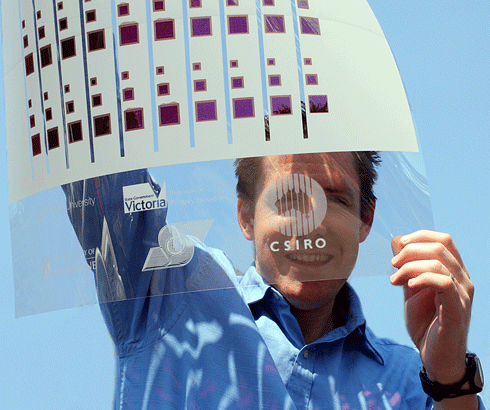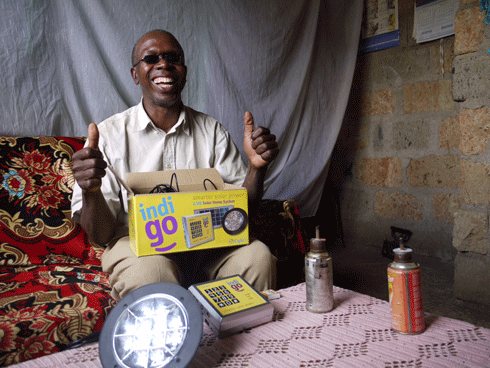
|
Published: 12 June 2012
‘Printed power’ to light the world’s darkness?
In too many parts of the world, grid-connected electricity remains an unattainable luxury. However, the rise in living standards in some developing countries has brought with it access to decentralised power generation – mainly solar power. The latest solar cell technology, flexible solar cells based on thin plastics, heralds a new generation of ultra-low-cost lighting for poor communities in remote areas.
In remote communities, local (or distributed) power generation is the only option available. In the least developed areas of the world, even local power generation is rare. This lack of access to privileges that we in the developed world take for granted – power to keep medicines cool, or to provide lighting to study by – has a major impact on people’s health, education and quality of life.
Recent developments in solar power are making it a more viable option for decentralised electricity generation. By taking light from the Sun and converting it directly into electricity, we can harness an effectively limitless source of power with few by-products or waste.
However, cost has always been a limiting factor. In the early days of solar power in Australia, the need to deliver electricity to remote locations and early telecommunication networks drove its commercial deployment. More recently, grid-connected solar systems have found favour with households, largely as a result of government subsidies. In 2001, Australia’s total installed photovoltaics capacity was 34 mega watt-peaks (MWp); by 2011, this had risen to more than 1400 MWp.1
This increase in market demand has been more marked in countries such as Germany and Japan and has led to a huge increase in solar panel production, mainly in China. As a result, prices have fallen significantly. But, even at a subsidised price of around AU$1 per watt, the cost of solar is beyond the reach of most developed-world consumers, let alone people in the developing world.
Ultra-low-cost solar cells based on plastics could change this cost equation. Our team at CSIRO is focusing on the emerging field of flexible electronics known as organic photovoltaics (OPVs). Like traditional, silicon-based solar cells, OPVs convert light directly into electricity. However, the similarity ends there. What goes into OPVs and the way they are made differs radically to silicon-based solar panels.

|
|
Scott Watkins with a roll of thin film solar cells: the active layer is 200 times thinner than a human hair. Credit:
Tracey Nicholls/scienceimage
|
Plastic is cheap. We already rely on cheap plastics in many areas of our lives. Power cords, for example, are wrapped in insulating plastic to stop us from being electrocuted.
Plastics are also versatile. Certain plastics – known as conjugated polymers– can conduct, rather than resist, electricity. This makes conjugated polymers an ideal active material for an emerging display and lighting technology known as organic light-emitting diodes (OLEDs). Conjugated polymers can also be used in OPVs.
In a typical OPV, a conjugated polymer is mixed with another substance known as a soluble fullerene (a derivative of C60).2 A thin film of this blend is then sandwiched between two electrodes, one of which is transparent. When sunlight is absorbed by the conjugated polymer, the energy can transfer an electron from the polymer to the fullerene. This initiates a flow of charge through the cell and establishes a voltage between the two electrodes.
An OPV solar cell is both lightweight and flexible. The active layer is only around 100 nanometres thick – 200 times thinner than a human hair. When packaged, OPVs look and feel like potato chip packets. OPVs can be made using the same process used to print food labels or Australia’s polymer banknotes. This makes high-volume production of large-surface-area solar cells possible at a low cost – a paradigm shift in the solar cell cost equation.
In the developing world, low-cost OPVs could be coupled with thin batteries and efficient lights (e.g. LEDs) to bring electric lighting to the millions currently reliant on kerosene lamps. These are not only polluting and a fire risk, but also require the transport of fuel.
The solar cells’ lightweight, flexible nature also removes the need for the weight-bearing roofs required to support heavy, silicon-based panels. In communities where thatch or plant-based roofing is used and regularly replaced, easy-to-handle solar cells could be moved on and off the roof as needed. In the simplest case, a solar panel with an integrated thin battery and light could be left in sunlight during the day and hung inside from the ceiling at night.
Researchers around the world are working towards such applications. Since 2009, a group led by Professor Frederik Krebs at the Danish Renewable Energy Laboratory (RISO) has been exploring precisely this application. These devices have already been deployed in Africa, and researchers are continuing to improve their performance.
More recently, Eight19, an OPV spin-off from Cambridge University in the United Kingdom, has proposed a pay-as-you-go system to fund the operation of OPV chargers and lighting units in the home, without the need for up-front investment.

|
|
Samuel Kimani from Kenya with his Eight19 OPV lighting system and recharging unit. Eight19 Ltd |
In Australia, I am part of the Victorian Organic Solar Cell Consortium (VICOSC), a partnership working to develop the materials and processes that will enable the commercialisation of OPVs. My team at CSIRO works closely with colleagues at the University of Melbourne, Monash University, BlueScope Steel, Securency, Innovia Films and Robert Bosch SEA. Our aim is to develop OPVs that can be printed directly onto plastic or steel substrates, enabling, for example, a roof to become a large solar panel.
How efficient are OPVs compared to silicon cells? In the lab, small-scale OPVs with an efficiency of 10 per cent have been reported. This compares with efficiencies of 12–15 per cent for a typical silicon panel today.
However, in applications such as solar-powered lights, the amount of power produced is more important than the cell’s absolute efficiency. Current predictions are that a power output of around 50 watts per square metre from printed devices is achievable within the next year or two. At this level, a battery charged up by sunlight during the day could provide more than enough power to light a room at night.
Dr Scott Watkins is Stream Leader, Organic Photovoltaics, within the CSIRO Future Manufacturing Flagship. Contact details: email scott.watkins@csiro.au Twitter: @FlexElectronixx
1 A watt-peak (Wp) is a standardised measure of the power of a photovoltaic solar energy device under laboratory illumination conditions.
2 A fullerene is a molecule composed entirely of carbon, in the form of a hollow sphere, ellipsoid or tube. ‘Buckminsterfullerene’ (or buckyball) is a spherical fullerene molecule with the formula C60; it is the most commonly naturally occurring fullerene molecule, and can be found in small quantities in soot. Its discovery and unique properties has led to a new field of chemistry based on fullerenes.




